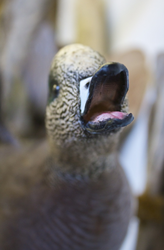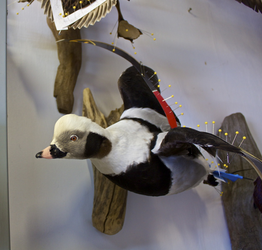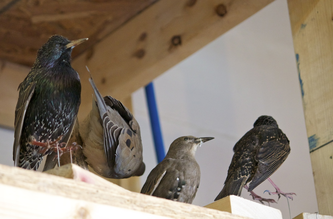|
The Breadcrumbs widget will appear here on the published site.
The Bird FactoryBy Josephine Stone QuailBellMagazine.com Taxidermy, by definition, is an art. When most hear the word, they think of dead animals snarling as trophies on hunters' walls---stuffed animals grotesquely mimicking what they once were, button-eyed and, honestly, unrealistic. Taxidermy began as a means for primitive hunters to forage and preserve furs and skins. Since the early 20th century, taxidermy has grown into a scientific and artistic occupation that perfects the anatomy of recently deceased animals for the purpose of study and aesthetic appeal. Despite its current status as a reputable position, the occupation remains mostly mysterious to the general public. After all, we are far beyond the primal hunting techniques and trophies of thousands of years ago. When I met Richmond, Virginia's Robert Olson, however, I realized that an actual love for animals inspires many modern taxidermists. On a quiet block of West Moore Street surrounded by vacant buildings, furniture stores and car shops, Robert Olson works full-time recreating a single moment in the lives of deceased birds. He spends most of his time in his shop, Frozen in Flight, so getting a chance to meet him in his work space was easy to do. After pushing down the buzzer at the front door a handsome young man answered with a smile on his face---not the pallor or personality of the Norman Bates type one may expect. After brief introductions, Olson led me to his show room--a small space where several types of birds, ranging from songbirds to water fowl, grace the walls on mounts and branches. A corner of the room has a life sized piece of sidewalk, complete with parking meter, where two pigeons feed on found fast food. "I actually measured the sidewalk out in front of Lowe's on Broad Street for that one," Olson says in his southern drawl. This gallery belonging to the University of Georgia Wildlife Biology graduate captures a glimpse into the life of each bird in its natural habitat. Standing awestruck among the many birds, either resting on branches, taking off into flight, or fighting over a French fry, I was eager to see Olson's workspace where all of these birds' endings began. Frozen in Flight is located in a building that houses a couple of different businesses, so we had to exit through the front door and circle around to a garage-door-like opening in the back of the building. Olson rolled up the metal door from the bottom and revealed a shop as a small as the gallery. It was a pristine prepping area with an industrial sized sink, a wooden table surrounded by tools, a large wall with drying and mounted birds (works in progress), and a large shelf full of various mounts and wood stands above a large pile of saw dust. This is where the magical reanimation happens. In pointing to each corner of the room Olson explained the steps it takes to taxidermy a bird, simplifying the details to help me understand. On a Monday or a Tuesday he does the skinning and cleaning of the several birds he took out of the freezer on Sunday. The rest of the week is spent mounting the birds, with each bird taking a different amount of time. That means anywhere from 4 or 5 hours for smaller birds like quail and ducks (without a habitat/mount) and up to a day and a half for turkeys and swans. On Saturday Olson spends the day doing finishing work to the outer appearance of the birds, like painting feet and bills, and getting them on bases. At least once a week, he tries to cast several heads and paint them all at once, like an assembly line, to have them all prepared for when the birds' bodies are ready. "It's like a bird factory," Olson said, laughing. "That was going to be the name of this place if Frozen in Flight was taken." Olson explained that he takes a different amount of care with each bird based on how it was retrieved and the condition it was in when he received it. He has to remove the bird's complete innards, choose eyes for the bird, and paint any colors that faded after death. He also had to put stuffing, like a wire frame and/or foam base, into each bird to give the body shape. Olson has to consider how to position the bird's body and where to place it, whether on a plaque, piece of driftwood, or mini habitat. After Olson pulled out several small drawers on his wooden desk to show me the various species-specific fake eyes that are neatly organized in each, he pulled up a trap door in the floor that led to even more storage. He disappeared for a few moments and returned with different types of bird stuffing, explaining again that most situations are bird specific, and that every taxidermist does things differently. Some of Olson's frames were wire wrapped into different sized bird forms and stuffed with cotton and string. The wire allows for malleability in neck and wing movement for different positions on mounts. Foam and plastic bodies fit to fill a standard bird form that can be carved for different sizes. All in all, Olson is prepared for any bird of any size and eye color. Olson, full of life and laughter despite his daily time spent with the dead, explained that he has been interested in birds since he was 5 years old. He reflects on his first hunting trip with his dad for doves when he was 13 years old, and how he appreciated the necessity of learning about their habitat and history in order to do so. "The whole process was pretty neat," Olson said. Hunting birds was the first step that led him toward the taxidermy field; he took further steps by enrolling in courses around the country. Olson explained that anyone can become a taxidermist as long as they have no wildlife-related violations. To get started, one must submit an application with the state and receive a license after approval. Taking courses, however, is something Olson finds as a necessary part of correctly and quickly learning the art. "I've taken courses in Louisiana, Oregon … You can really go anywhere. I even give classes sometimes. Most classes are one on one," Olson says. His experience, however, is limited to the bird world. "If I weren't doing birds, I wouldn't do taxidermy at all," he said. The great majority of Olson's clientele, despite the artistic nature of his work, are hunters. (He calls them his "bread and butter.") But the demand for collectors and museums still exists marginally. Off the top of his head Olson could think of a man in New York who collects pheasants and a man in England who collects pigeons and doves. Olson has even met the requests of pet-owners. Recently, for instance, a lady requested that he taxidermy her late canary. "The only issue with doing pets is you have to make sure [the pet] looks exactly as it did when it was living. This woman had had the canary for 10 years, and I had to make sure it looked exact because the owners know the bird's personality, which is different from a hunter who had just killed the bird without knowing it and brought it right here," Olson said. Pets and special collections, however, are still far and few between compared to the number of canvas backs, wood ducks and mallard orders Olson receives. Right now he has 160 birds to taxidermy, with about 80 left to do. All of his hard work pays off when he attends state, regional, national and world taxidermy competitions throughout the year. In May 2011 Olson went to the world competition where he said the judges are "nit-picky" to the smallest detail, with points being deducted for imperfect nasal passages and eyelids. So perfection is what he strives for with each piece created at Frozen in Flight. Outside of harsh judgment at competitions, Olson said the hardest part of running his own business is time management, and the fact that birds will always be very difficult to taxidermy. As a parting word of advice for those who are interested in the art of taxidermy, Olson said, "Go to a taxidermy show and see what it's all about. Talk to someone there who could give a two or three day course so you're not going in blind. I also find that most questions can be answered on the forums at Taxidermy.net." For those interested in having a bird preserved, place your deceased bird in a Ziploc freezer bag, and be sure to push all of the air out (air causes freezer burn), and then call a taxidermist. At Frozen in Flight most birds range between $170 to $200. Larger birds like turkeys and swans range from $700 to $800. In order to taxidermy a threatened or endangered bird, you must obtain a permit and have the mounted bird publicly displayed. Frozen in Flight Taxidermy 3119 West Moore Street, Suite B Richmond, VA 23230 USA Robert Olson (804) 38-BIRDS | (804) 382-4737 [email protected] CommentsComments are closed.
|
|

















